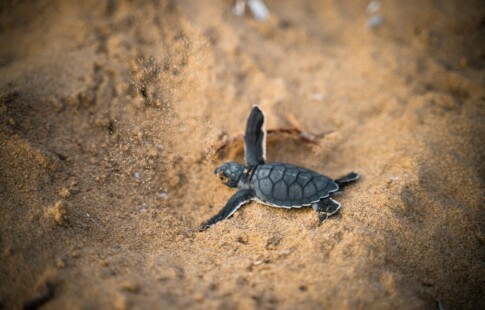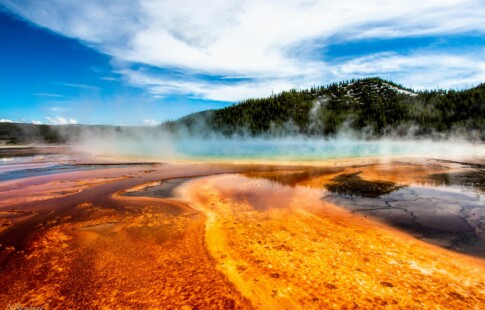
Crocodile vs. Alligator: 8 Key Differences
We are reader-supported. When you buy through links on our site, we may earn affiliate commission.
Crocodiles and alligators are two of the oldest reptiles on Earth. However, although they resemble each other and display similar behaviors, they have numerous characteristics that set them apart. If they went head to head, one also has a much better chance of winning.
If you struggle to tell the difference between the two, these eight facts will help you pinpoint exactly which is which.
1. Alligators Are Black or Dark Green
Typically, renderings of alligators show them as a bright green color —due to the algae and floating plants they hide in. However, the animal is a dark grey with a lighter belly — juveniles also have golden stripes that fade as they age. The dark colors help camouflage them in the wild so they can hunt and avoid larger prey.
For example, there have been instances where the invasive Burmese python has eaten alligators in the Everglades. Female Burmese pythons lay around 100 eggs yearly and are one of the alligator’s most threatening competition.
Conversely, crocodiles are a lighter brown-gray — sometimes with a hint of yellow-green. According to a 2018 study, crocodiles can change their skin color rapidly depending on environmental conditions. Usually, their adaptive coloring reverses within 60–90 minutes — possibly because of thermal regulation or hormonal changes.
2. The Snouts Are Shaped Differently
Don’t know whether you’re looking at an alligator or a crocodile? Check out its smile. One of the more obvious ways to tell an alligator from a crocodile is to look at its snout.
Alligator snouts are large with a rounded curve. A fully-grown alligator has 80 teeth and will typically lose and replace up to 3,000 teeth throughout its lifetime.
Regardless of the species, crocodiles have a much narrower snout. Unlike the alligator, crocodiles have an overbite and an underbite, giving them a jagged, toothy grin. You’ll only see a croc’s upper teeth when its mouth is closed, and Oceana says a saltwater crocodile’s teeth could reach five inches long — 13 centimeters.
3. Crocodiles Have a Stronger Bite
Obviously, you’ll want to avoid an alligator and crocodile mouth at all costs. However, their teeth aren’t the only thing you must worry about — both also have a powerful bite force.
The highest bite force for a saltwater crocodile ever recorded was 3,700 pounds, with a pressure of 350,000 pounds per square inch (psi). The record for an American alligator was 2,980 lbs. With a bite that strong, does it really matter whose jaws you get caught in?
4. Crocodiles Are Larger than Alligators
Saltwater crocodiles are the largest crocodilians on the planet. On average, male crocodiles measure 17 feet long and weigh 1,000 lbs. However, some crocodiles can grow as long as 23 ft and weigh 2,200 lbs.
Alligators are much smaller in size. Males tend to average about 11.2 ft and 1,000 lbs. Meanwhile, adult females are usually just over eight feet. Typically, male gators — sometimes called “bull gators” once they’ve reached over nine feet — grow much faster.
The Louisiana Alligator Advisory Council says alligators grow about 12 inches annually, with growth rates slowing down as they age. Similarly, crocodiles grow one foot annually for the first three to four years of its life.
5. Gators Can Endure Cooler Temperatures
American crocodiles cannot endure cooler temperatures and many die in cooler temperatures. You can find them in the saltwater marshes of Florida, where the weather rarely dips below a balmy 80° Fahrenheit. Worldwide, crocodiles thrive in Asia, Australia and Africa.
However, alligators — usually found swimming in freshwater between Florida and North Carolina — can survive cold blasts with “icing.”
Icing may be alarming to onlookers — an event where alligators stick their snouts out of frozen water, such as a lake, canal or creek. To achieve this, they lower their metabolic rates until they become lethargic.
6. Crocodiles Are Older Than Alligators
Many people believe that crocodiles and alligators have remained unevolved since the dinosaurs. While they look prehistoric and are undoubtedly old, that’s a myth.
Crocodilians belong to a group of Jurassic reptiles originating 205 million years ago — the Sarcosuchus, which measured nearly 40 ft long. Archeologists have indicated Sarcosuchus even fed on dinosaurs. Nevertheless, modern crocodiles have existed for about 85 million years — much longer than the American alligator.
According to research, the oldest southeastern American alligators evolved 18 million years ago during the early Miocene period. Alligators in Nebraska and South Dakota existed 34 years ago during the Oligocene period.
7. There Are More Crocodile Species
There are only two alligator species in the world: American and Chinese. Unfortunately, the Chinese alligator is critically endangered, unlike its American counterpart.
Contrarily, there are 24 recognized crocodile species, including the American, West Nile, saltwater, Cuban, West African and Phillippine crocodiles.
Most alligators are found in North and South America, while crocodiles are more widespread. However, Florida is the only place in the United States where alligators and crocodiles co-exist.
8. Alligators Are Less Aggressive than Crocodiles
Crocodiles are usually more aggressive than alligators and tend to look for food — or trouble. On the other hand, alligators are shier and won’t go out of their way to chase after their dinner. Of course, that doesn’t mean swimming with them is safe.
Stories of crocodile and alligator attacks are shocking but not as common as you’d believe. Despite being found in every Florida county, only about 10 unprovoked alligator attacks happen annually, requiring medical attention.
Often, you’ll hear stories about crocodiles terrorizing villages and eating livestock — yet, the Ramree Island Massacre is still considered the worst crocodile attack ever recorded. The incident occurred in February 1945 in Burma — modern-day Myanmar — as Japanese soldiers attempted to retreat from British forces in the mangrove swamps. Limited records depict horrific deaths at the mouths of crocodiles, from tens of people to hundreds.
Crocodile vs. Alligator: Who Would Win a Fight?
Considering its bite force, size and sheer aggression, you can count on a crocodile beating an alligator in a fight. However, crocodiles and alligators are not the species you want to encounter in the wild. It’s hard to say whether anyone can stand a chance with reptiles who’ve survived millions of years of evolution.
Share on
Like what you read? Join other Environment.co readers!
Get the latest updates on our planet by subscribing to the Environment.co newsletter!
About the author

Steve Russell
Steve is the Managing Editor of Environment.co and regularly contributes articles related to wildlife, biodiversity, and recycling. His passions include wildlife photography and bird watching.





